This post will do you a world of good if you agree with this one very simple premise:
You’re far more likely to achieve success and move the needle on your business’s bottom line with content marketing if you have a documented content marketing strategy.
See also: Guides to Brand Awareness, Lead Generation and Performance Marketing
Research from Content Marketing Institute and MarketingProfs indicates content marketers with a documented strategy are:
- Much more likely to consider themselves effective at content marketing
- Far less challenged with the many aspects of content marketing
- Able to justify why a higher percentage of the marketing budget should be spent on content marketing
For several years running, the same research has consistently found that a content marketing strategy separates successful content marketers from their less successful peers.
According to a 2017 Contently survey, 98 percent of marketers believe “having and following a content marketing strategy is important for content marketing success.”
Your content marketing plan serves as a guide to getting started, staying the course, and perpetually improving your results. The insights it contains makes it easier to plan and manage all your tactics.
Let’s look at what a content strategy is and what it is not, the benefits of having a strategy, and step-by-step guide to making one for yourself.
What is a Content Marketing Strategy?
A content marketing strategy maps information like the business goals content marketing supports, the audiences you’ll targeting, the goals you’re measuring yourself against and more. It’s a well-researched and well-documented answer to the question, “why are we doing content marketing?”
It’s different from a content strategy details how you manage all of your content. For example: how often should you evaluate your blog articles? Are old case studies still useful for your sales team? Is the product information in your set of e-books up to date? Where do you find all of this content and how is it organized? As you can see, a content strategy typically goes beyond content marketing, and covers all content a business creates.
There’s a third twist in the mix here—the content plan, not to be confused with either your content marketing strategy or your content strategy.
Content Marketing Plan
In contrast to a content marketing strategy, a content plan is tactical—it’s how you create, publish and govern your content strategy, and often includes things like channels, publishing platforms, content calendar, key topic areas, budget and who on your team is managing various projects.
While the terms content marketing strategy and content plan are often used interchangeably, they’re very different. A content marketing strategy focuses on the business goals, and how content can support them. A content plan defines exactly how that support will be executed.
Content Marketing Strategy vs. Digital Content Marketing Strategy
A content marketing strategy isn’t the same as digital content marketing strategy. While content marketing strategy maps all of your content marketing activities to business goals, a digital content marketing strategy focuses specifically on how you will do so online.
For example, a content marketing strategy might include things like a print magazine, bylines written for print publications and other forms of offline activity.
Have you ever seen the LEGO movie? It’s a perfect example of a one hour and 41 minute long video that exemplifies offline content marketing.
A digital marketing strategy includes how you will strategically hit your business goals, reach your target audiences and measure your goals with online activities—like a blog, social media channels, online video and more.
Sticking with the LEGO example, they also create short videos for their YouTube channel, including their LEGO Star Wars series, which was released using the hashtag #MayThe4th. These have the express purpose of engaging their audience in an online setting, whereas the movie was part of a much broader campaign.
Both your content marketing strategy and your digital content marketing strategy should map your content plan to the buyer journey with the express purpose of supporting your business goals.
Why is a Content Marketing Strategy Important?
Content marketing is important because it directly links the money or time you’re spending on content to your business goals, allowing you to expressly communicate how you’re contributing to the bottom line.
If you’re always aligned with your business goals, you’re in a much better position to prepare and plan to reliable and cost-effective sources of website traffic, leads and sales.
What is the Benefit of Content Marketing Strategy?
The benefits of a content marketing strategy are aplenty, but in short, a content marketing strategy allows you to do the following:
- Ensures that your work is worth it to the business by always supporting a goal the entire organization agrees is a priority.
- Ensures that you have a framework for measuring any ROI of time or money creating content.
- Ensures you’re reaching the right people. By mapping your audiences before you create content, you ensure you’re always speaking to the right person.
- Ensures that you don’t get caught in the ‘more content’ trap. If you’ve written one blog post or E-book that’s continuously driving results, then you can easily make the choice to experiment with new types of content or focus on redistributing that content over and over again, instead of creating for the sake of creation.
How to Develop Content Marketing Strategy
Developing a content marketing strategy can be done in just a few easy steps. We’ll break down how to get started.
1. Establish Your Goals
At the risk of stating the obvious, you’re not going to achieve your content marketing goals unless you’ve established what they are.
Practical content marketing goals tend to focus on ways to increase sales, reduce marketing costs, and support business growth initiatives.
Consider documenting one or more of the following goals as a starting point for your strategy:
- Improve brand awareness
- Increase engagement
- Generate more website traffic
- Expand the email list
- Increase marketing ROI
- Achieve higher customer retention, loyalty and referrals
Ultimately, you’ll want to define and gather specific metrics to gauge the progress you’re making toward achieving your content marketing goals. I won’t get deep into this topic here today, but I recommend the following resources:
- Content Marketing Metrics: 10 Easy Ways to Measure Effectiveness—I wrote this post on the Orbit Media blog to help content marketers get started with basic metrics.
- How to Match Key Metrics with Your Content Goals—from Content Marketing Institute
- The Comprehensive Guide to Content Marketing Analytics and Metrics—An in-depth exploration of the topic from Curata
Goal-Setting Framework
The most popular goal setting framework is SMART goals—they’re specific, measurable, achievable, relevant and timed. If your goals don’t fall into one of those buckets then it’s probably not a good goals.

2. Identify Your Target Audience
Who do you want to read, watch, view and/or hear your content? This critical question must be answered in detail. The process of identifying and defining your target audience introduces the idea of buyer personas.
A buyer persona reveals what prospective customers are thinking and doing as they weigh their options to solve a problem.
“Actionable buyer personas reveal insights about your buyers’ decisions—the specific attitudes, concerns and criteria that drive prospective customers to choose you, your competitor or the status quo.” – Source: Buyer Persona Institute
Personas, as they relate to planning your content marketing strategies, help you make informed decisions about topics to cover, content formats to utilize, and how you’ll approach your subject matter.
The idea, of course, is, in order to create the most relevant content you need to understand precisely what your target audience values.
My simplified approach calls for filling in the blanks in this table:
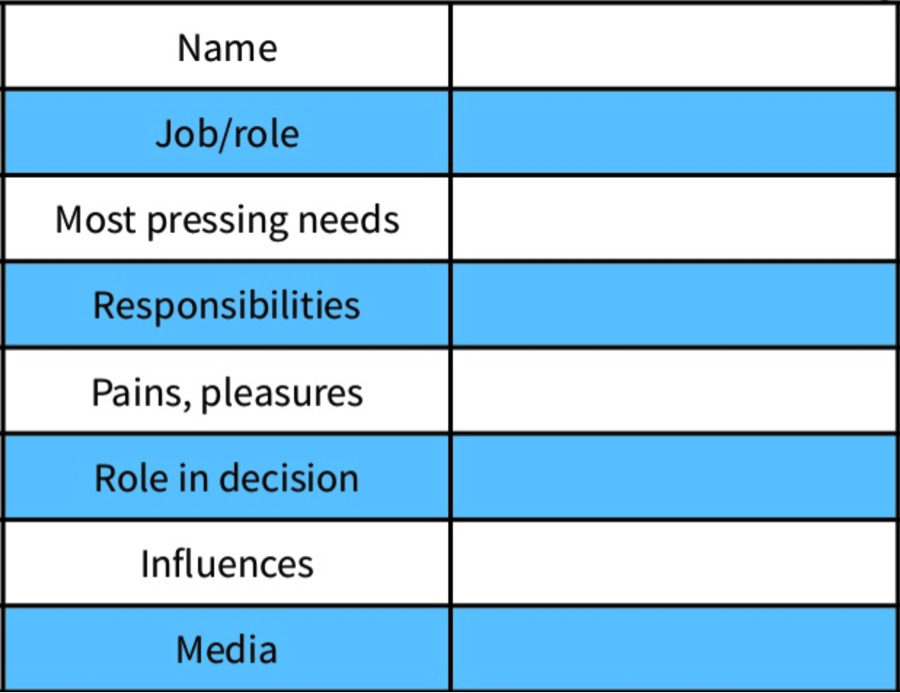
The degree to which you dig into each area is entirely up to you. You may want to create your buyer personas aided by a more detailed template. A few of the many free sources you’ll find useful include:
- A detailed, multi-tab template from Buyer Persona Institute
- Persona templates from HubSpot
- Persona template (and tips) from Alexa
3. Create a Content Marketing Mission Statement
This next step, creating a mission statement, is important but often neglected. However, it’s not the least bit complicated. You simply document the vision of your content, the audience it serves and the value it provides.
Here’s a fictitious example from my SlideShare lesson, Fast-Track Your Content Marketing Plan…

As a content marketer, you’re a publisher. Think of yourself this way and document a simple mission statement.Your content marketing mission statement will help everyone on your team make more informed content creation decisions and give your content a much-needed central theme.
4. Perform a Competitive Analysis
Take a close look at what your competitors are doing. Auditing and analyzing the content created in your market can be a valuable part of informing your strategy and content marketing process. The idea is to create a plan to differentiate your content.
On the Content Marketing Institute blog, Crayon CMO Ellie Mirman describes a simple three-step process for conducting a competitive content marketing analysis:
- Take inventory of your competitor’s content—Create a catalog of your competition’s content types, topics and media choices. Make note of the keywords they covet.
- Evaluate the quality of the competition’s content— How often do they publish—and in which channels? How does the audience receive the content? Mirman recommends looking for trends in engagement to understand how well the content is performing.
- Analyze the topics they create content about—Finally, analyze the topics of the competition’s content in an effort to identify potential content marketing gaps, which could be opportunities for your brand.
5. Plug Content into Your Buyer Journey Matrix
Everything I’ve covered thus far requires a good deal of careful and calculated work, but is relatively easy compared to the processes that lie ahead.
See, it’s time to forge a plan for content creation—and though setting goals, identifying your audience, forging a content marketing mission statement and examining the competitive landscape all contribute to increasing your focus, you really won’t know exactly what to create.
Understand, every content type or actual media production won’t be a home run.
But hear me out: I’m not telling you everything you do here on out is a guessing game. What I’m saying is the process of planning, creating, publishing, and content promotion is iterative and experimental. If you’re doing things correctly, you learn from both your triumphs and failures.
Begin with a Buyer Journey Matrix
As you know, the process of buying (or selling) is often thought of as a funnel. Your content marketing funnel should be mapped to your sales funnel. Though yours may include—or evolve to include—more than three stages, the basic three stages breakdown like so:
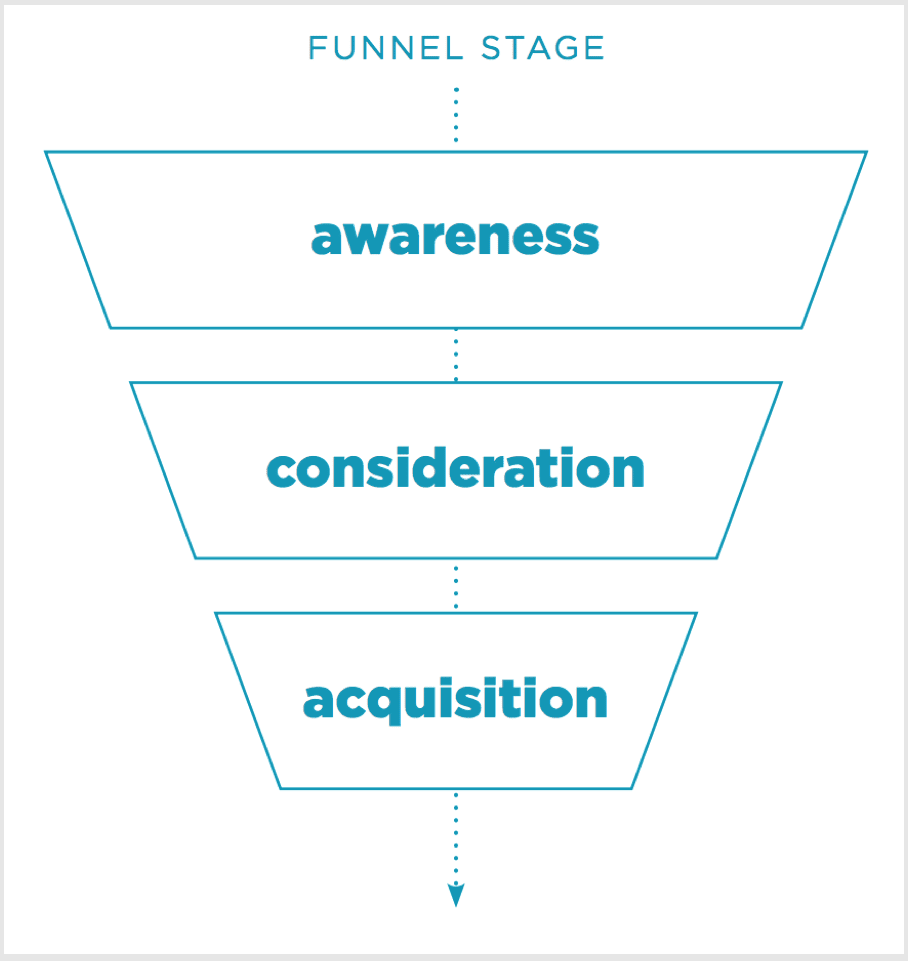
And so I recommend creating a content matrix accordingly:
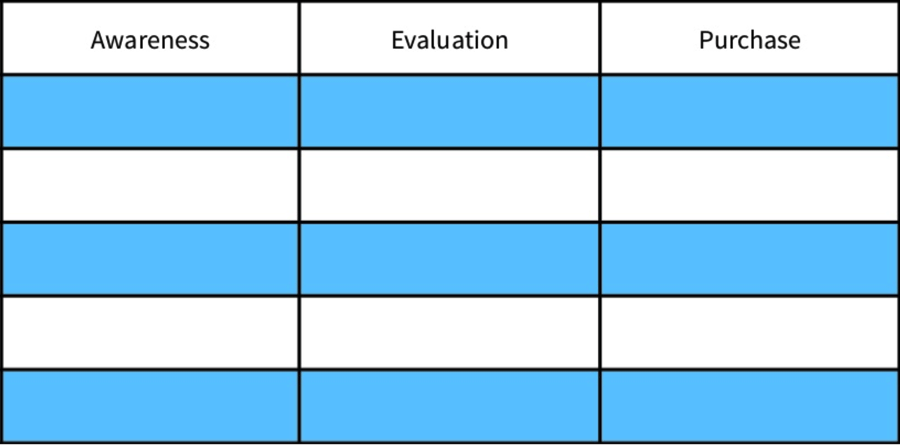
Note the matrix here represents only ONE buyer persona. Should your content marketing plan target multiple personas from the get-go, you’ll need more than one matrix.
Next, you plug in content types. At this point, don’t concern yourself with specific topics. Specific content assets are more relevant to buyers at specific stages (as demonstrated by this presentation from the #Inbound13 event.
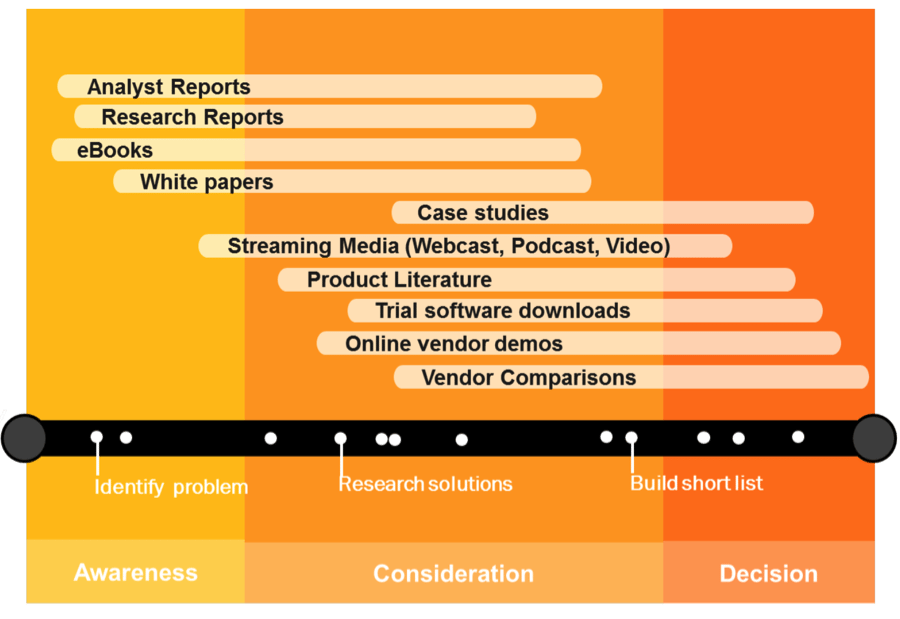
The presentation’s author points out how buyers (in this case B2B buyers) have different needs in each stage:
- Awareness—Prospective buyers seek educational, third party, vendor neutral content.
- Consideration—Users are committing to solving their problem and are more focused on solutions and comparisons.
- Decision—Users seek validation in determining their short list and making a decision.
Here’s another presentation of the same idea, which has been refreshed, from SpinSucks, which you’ll find useful (though I’m not sure why the funnel doesn’t decrease in size—as it will—as some prospects progress through it while others check out):
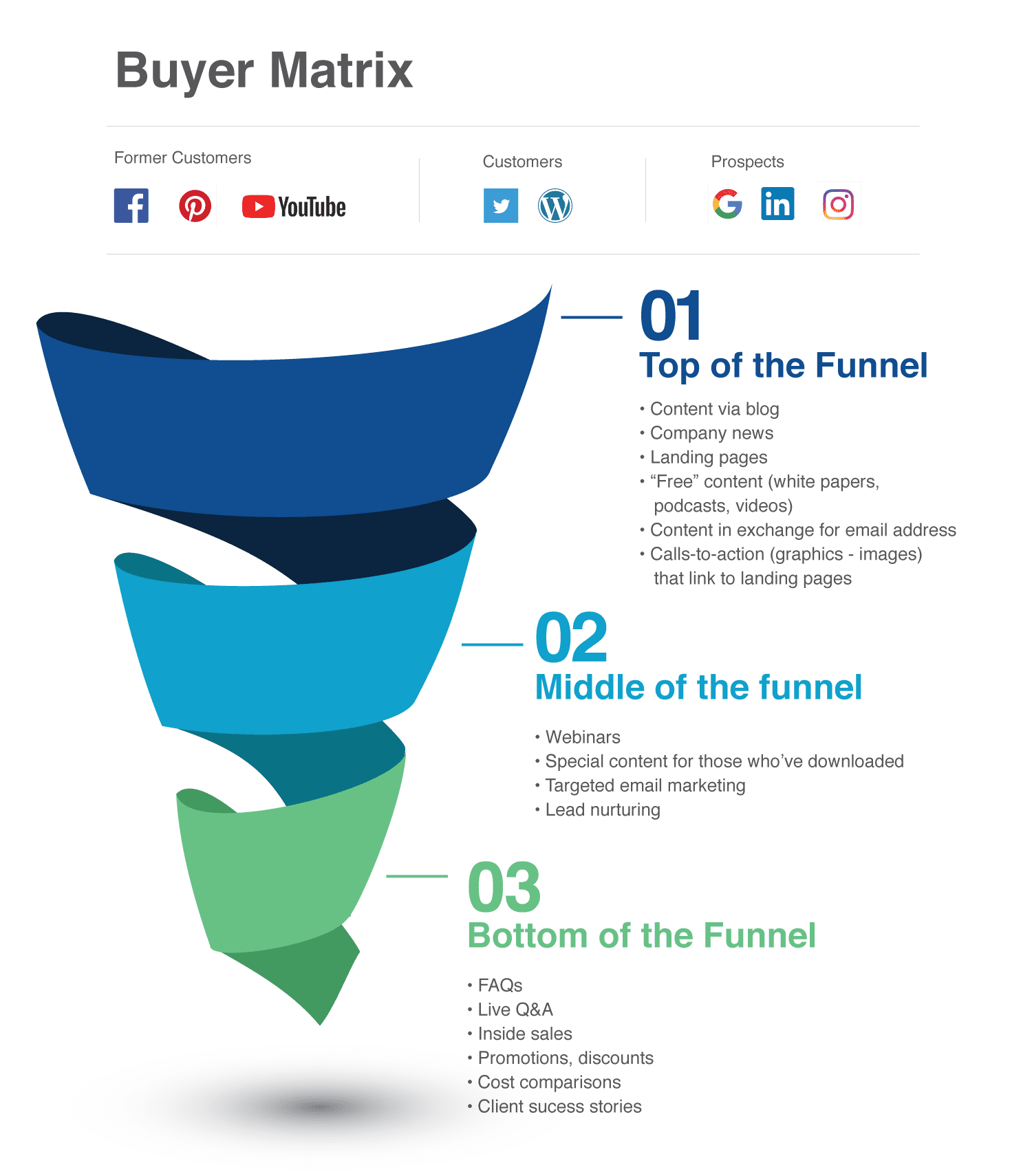
Now what?
- Consider content you already have. Where can it be plugged in?
- Consider creating new assets from existing content. For instance, can a sales deck become a blog for top of the funnel marketing or a webinar for the middle or bottom?
- Consider your resources—currently available vs. wishful or future resources.
- Consider which assets you can produce in a reasonable time frame, but…
- Think big. For instance, you may determine you need content for various stages that will require a commitment you’re not yet ready to make.
- Prioritize.
Again, hard-and-fast answers may not come easily, but thanks to your efforts to document your most pressing goals, you should be equipped with insights to make practical decisions about which to tackle first.
6. Create a Short List of Content Pillars
A practical plan of attack for establishing the topics you’ll tackle with your content is to explore content pillars you’ll build into your content marketing strategy.
Think of a content pillar as a key theme that will support your publishing efforts. Each should be:
- In line with your brand and offering and specific enough to trace closely to how your solution maps to the needs of your prospects and customer, but…
- Broad enough to enable you to create a stream of content that “branches off” from the central theme while providing value.
Say we’re talking about a blog (as we often do when exploring content strategy). Your content pillars can simply be the categories of topics you’ll cover.
As an example, here are some of ours:
- Brand Awareness
- Content Marketing
- Driving Traffic
- Landing Pages
- Lead Generation
- Native Advertising
- Performance Marketing
- Video Marketing
There’s no need to look any further than our own blog to understand how pillars inform your content creation strategy. When we create content at Taboola it has to adhere to one of the themes above.
Content pillars also often inform “big content” (which I’ve seen referred to as bedrock content, cornerstone content, big rock content, content pyramids, divisible content, and yes, even content pillars).
Here’s the point:
Whatever you might call it, we’re talking about a substantial piece of content on a specific topic or theme that can be repurposed in a variety of forms across a variety of channels.
Examples include eBooks, reports, guides, or even lengthy articles like the one you’re reading. A post on Kapost blog explains:
“By focusing your attention on creating a single content pillar, it’s easy to break that finished piece into blog posts, infographics, videos, emails, social media updates, and more, to attract different kinds of buyers through different channels.”“This method is an efficient and process-driven way to cover all of your content bases—and deliver the right content to the right buyer at the right time.”
When I advise my clients on the strategic way to approach content pillars—both as themes and a form of content, I suggest the following:
- Think evergreen. Produce content that will be relevant and useful for a long period of time.
- Chapterize. Work from an outline or table of contents that makes it clear how the “master” can easily be sliced into content to address subsets of it.
- Plan for repurposing. For example, think about how an ebook might include what’s needed to create an infographic, articles, social media posts, emails, podcasts, webinar, etc. In many cases (email, social media), you should have what you need to create several smaller pieces of content.
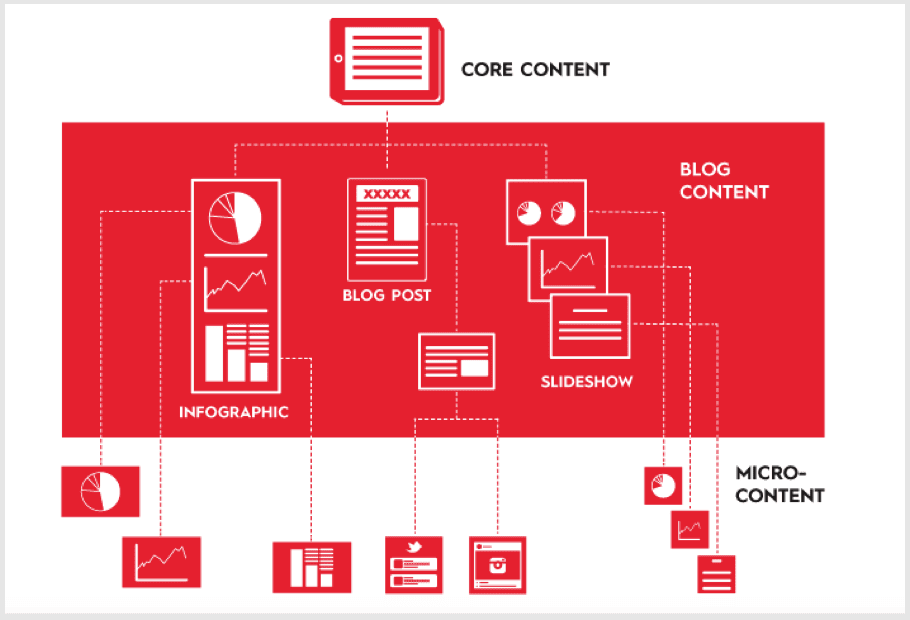
This family tree (or flow chart) from Column Five Media makes the “divisible content” strategy easy to understand.
7. Get to Work on Your Editorial Calendar
The rubber meets the road in this next substantial step: creating and maintaining an editorial calendar.
You can create it with an online tool. Trello is one of many collaboration tools editorial teams rely on. Asana works much differently, but is a popular choice. CoSchedule, which plugs into WordPress, claims its solution is “mission control for your entire editorial schedule.”
However your calendar can be an actual calendar or a spreadsheet.
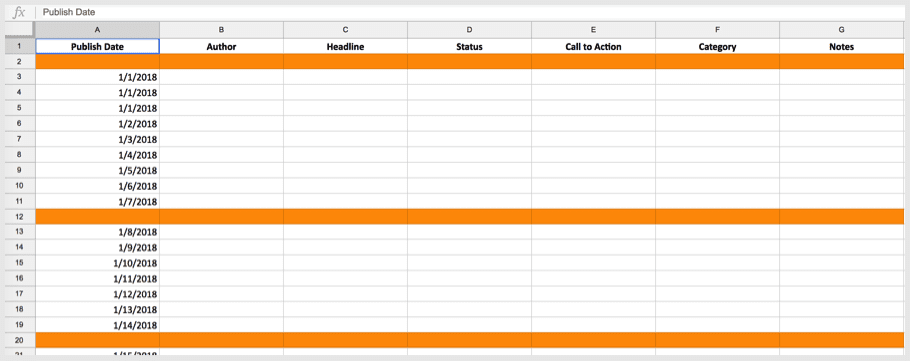
Content Marketing Institute makes their spreadsheet template available for free here. Note this particular calendar is specifically for blog posts and its columns make room for important details of each post. Additional tabs in the spreadsheet (not shown) allow for blog post ideas to be collected and works-in-progress to be tracked.
Here’s a similar style editorial calendar I’ve created:
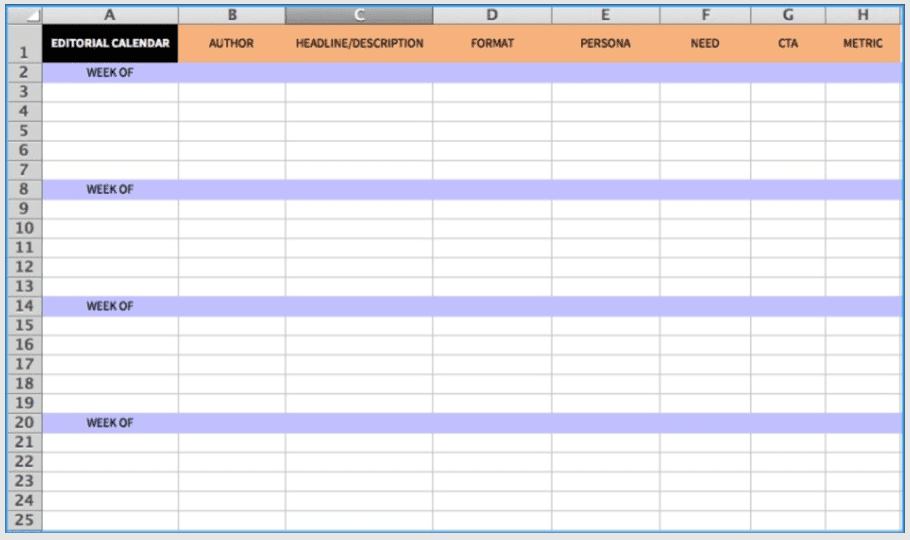
Look closely and you’ll see my columns don’t precisely match CMI’s. For instance, I’ve included “format” (e.g. infographic, video interview, etc.), persona, and metric.
You’ll want to customize yours to meet your needs and you can expect them to evolve.
Don’t torture yourself with an editorial calendar that looks too far forward. To be practical, look to pen your plan a month, or two, maybe a quarter, in advance. Any longer probably won’t be useful.
As you can see, your editorial calendar brings so much of what we’ve covered together. You’ve probably noticed it also gives rise to examining much more—including things we haven’t (and won’t) drill down on:
- Writing resources
- Workflow
- Approval processes
- Content formats
- Distribution channels
- Design requirements
- Calls to action
- And more…
8. Build KPIs into Your Plan
The “and more…” I just hinted at concludes with analytics. Few lessons regarding effective digital marketing don’t touch on the importance of measuring results. Doing so is critical for:
- Gathering insights to continuously improve your content marketing, and
- Demonstrating to your boss, peers and/or investors your efforts are worth continuing, and potentially, expanding
- Measuring ROI
Once again, we’re touching on a topic that’s its own big beast and worthy of further exploration. The crucial point is:
The many words you’ve chosen to use in creating your content marketing strategy must be slaves to the numbers your program produces.
This means defining your conversion strategy, or optimizing for the action you want people to take when they visit your content.
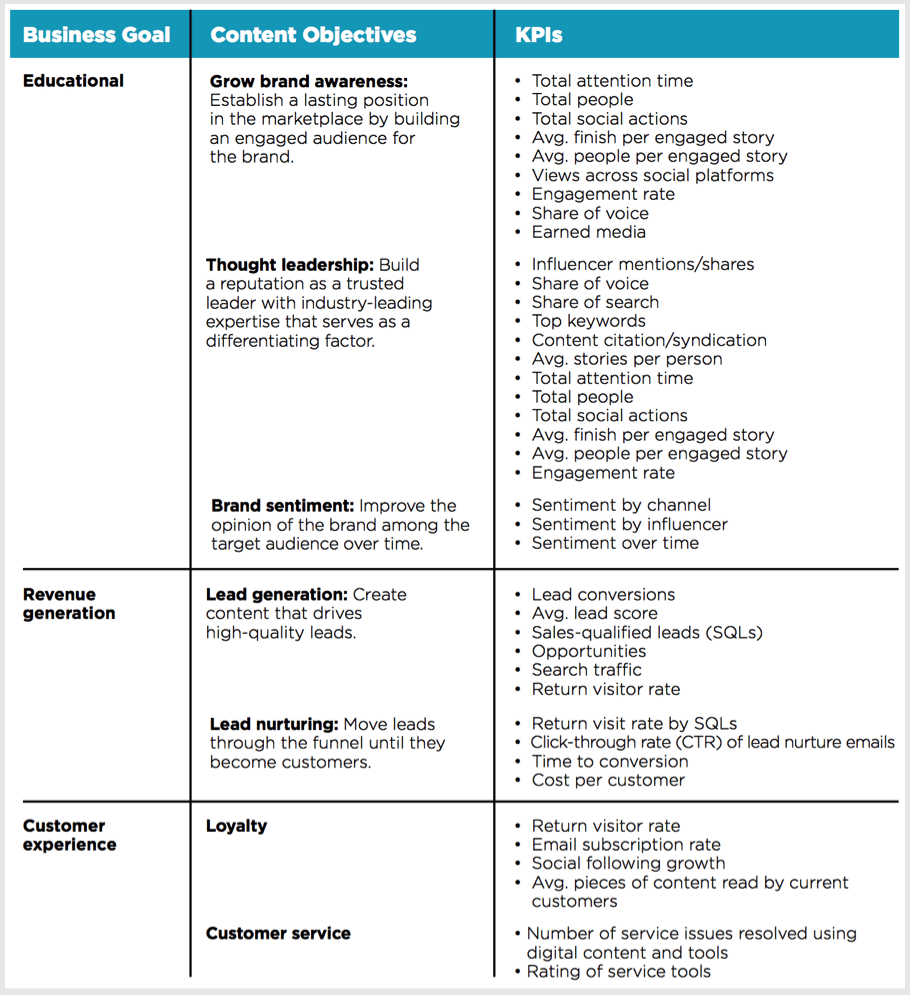
Please, don’t allow this extensive list of key performance indicators (KPIs) from Contently’s Content Methodology: A Best Practices Report scare you. I’ve offered it go give you ideas regarding your KPIs.
You need not measure everything, but you do indeed need to establish a core set of KPIs, a method to gather them, share them with key team members, and use them to inform your tactics going forward.
I recommend creating a content marketing KPI dashboard and updating it monthly. I also recommend using the results it reveals to update your content marketing strategy on a regular basis, maybe quarterly.
You’ll find it’s shortsighted to be long-sighted or overly rigid.
Content Marketing Strategy Examples
Let’s take a look at some examples of content marketing strategies in two forms: the first is examples of companies executing a content marketing strategy well. The second is a collection of templates that you can use to actually build a strategy, as we’ve detailed for you here.
Companies Executing Content Marketing Strategy Well
Marriott
Marriott has been hailed as the king of content marketing, and tripled the amount of revenue earned through its content site. Its secret is consistency, and always truly putting their audience first. They started out with just a simple blog, but after long, became a branded newsroom.

OppenheimerFunds Fact vs. Feeling Tool
They use science based on aging, emerging markets, emotional reactions and more to provide their audience with investment strategies that fit their comfort level—it’s cool, unique, and entertaining, an endorsed by the NYtimes.

Content Marketing Strategy Templates
No two content marketing strategies look alike. You might find slides more appealing, while others use spreadsheets or documents. If you’re not sure where to get started, these templates are a great jumping off point from some of the pros.
Buffer
Buffer’s template comes in the form of a downloadable Dropbox file and includes detailed instructions on how to get started.

Moz
Moz’s template is a 17-page Google Doc that walks you through exactly how to document your goals step-by-step.
You can use a discovery platform, like Taboola, to implement the content promotion portion of your content marketing strategy using discovery ads and native advertising.
A quick recap of your content strategy flight plan.
Here’s a concise overview of everything we discussed in this post:
- Begin by establishing your goals. Common focuses are sales, reduction of marketing costs, and the support of business growth initiatives.
- Identify your target audience. Use buyer personas, which reveal what your customers are thinking and doing.
- Create a mission statement. This documents that vision of your content.
- Perform a competitive analysis. Audit and analyze what’s already in the market, and take note of what’s not.
- Plug content into your buyer’s journey. This maps content to your audience and their needs, directly.
- Define your content pillars. These are the key themes you’ll focus on.
- Develop your editorial calendar. This is where the rubber meets the road, it’s your game plan.
- Finally, build KPIs. Map a content marketing KPI dashboard and update it monthly.
Remember, be agile. Effective content marketing strategies evolve along with the relentlessly changing modern marketing landscape.